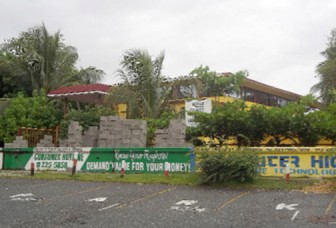Minister of Transport and Hydraulics Robeson Benn says that outstanding lease payments for the Celina Atlantic Resort were made and he is not aware of any change of ownership.
The resort was the subject of controversy last year over lease payments and its subsequent expansion on the site, with several engineers sounding their concern over the impact of the construction works on the sea wall.
Asked on Monday whether there were any concerns as to how the new buildings might impact on the seawall and whether the Sea Defences Unit would have had to give permission for the construction, the minister said, “I don’t know that our people had any specific look at it.”
He said that the issue will be followed up. He recalled that there was a time when the ministry had objected when construction materials were taken to the site but will have to follow up on this issue.
The resort was operated by Bernard Yhun who had launched a legal battle to stay in business after his lease was cancelled

by the Guyana Lands and Survey Commission (GLSC), which asked him to clear the Kitty Seawall site. Yhun’s lawyer, Manoj Narayan, later said there was nothing preventing the expansion, while noting that the High Court had dismissed applications by the GLSC for Yhun to be removed because of non-payments on the lease and to prevent him from erecting structures on the land.
Last month, a company official at the Kitty seawall location, who identified himself as “Mr Hong,” told Stabroek News that his “boss,” whom he did not name, had acquired the business. At the time, staff was being hired for the expanded popular hang-out spot.
While construction works have been ongoing at the facility for some time now, they have been enveloped in controversy. Former Chief Hydraulics Officer and Specialist Engineer for Sea Defences Malcolm Alli had said that the Celina Atlantic Resort building violates the Sea Defence Act and permission for its construction should not have been granted.
Alli had told Stabroek News that he had designed and built the section of the sea defence in 1968, following massive erosion of the foreshore.
He had explained that where the Celina Resort sits, to the north of the seawall next to the Kitty Pump Station, was the grouted boulder slope, below which has built up silt.
The Celina building, he said, is built over this silt, which can disappear overnight by erosion, causing the building’s foundation to collapse and damaging the seawall.
Ali has said that on account of severe erosion on the East Coast during the late 1960s, Parliament, advised by him and other engineers in the Hydraulics Division, amended the Sea Defence Act, preventing construction of buildings and other structures in several areas of the coast landwards from 50 feet to 1,000 feet from the centre line of the sea dam. He has also noted that only in rare cases is permission granted by the Sea Defence Board to build minor structures—for religious purposes—seaward of the sea dam, and the responsibility to remove same during an erosion cycle rests with the owners.
The resort is located in an environmentally sensitive area, which has prompted questions about the danger its recent expansion poses to the mangrove trees in the area.
Some time ago, when Stabroek News had noticed large quantities of construction material being ferried to the location, it had approached an official of the resort on whether expansion works were being done. The official at the time denied this and said only repair work to the decking and other areas were being done.
Entirely new structures are, however, being put up and sources note that these should have been approved by various agencies and the possible repercussions to the environment and the integrity of the sea defence in the area considered.
Engineer Bert Carter had previously opined that no one should be allowed to build any structure beyond the seawall, given the potential threat to sea defences while late engineer Melvyn Sankies said he thought the building was an obstruction. He explained that in the case of any emergency or disaster, full access would be needed in that area.




